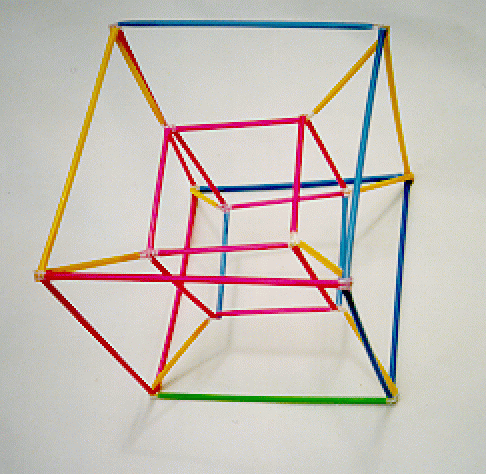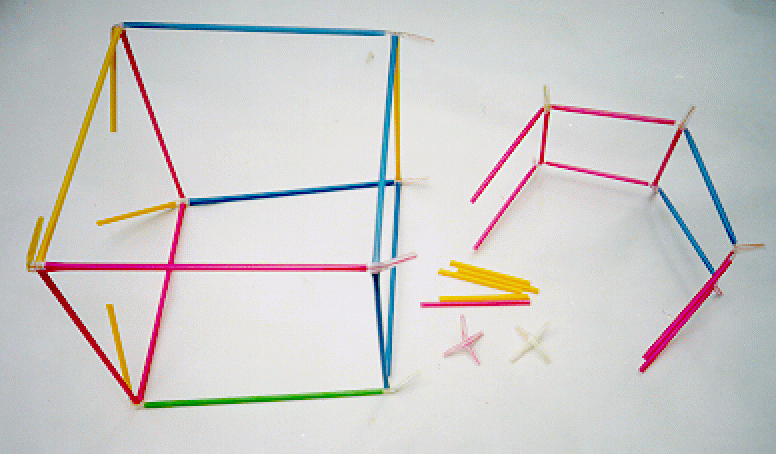An Introduction to the Vocabulary of Dimension:
activities
to accompany the posters: Squeeze the Phase Space and
Dusa McDuff.
This page presents a graded sequence of activities, ranging
in level from junior high school to beginning college. They
are designed to introduce students to the concept of dimension
and to geometry in space of arbitrary dimension.
The main manipulative activity is the construction
(requiring only 38 straight drinking straws and a small stapler) of
a 3-dimensional perspective projection of a 4-dimensional
cube, or hypercube. This activity can be carried out
completely by older students; for younger ones the teacher
may wish to do some of the cutting and measuring in advance,
or to ``farm out'' parts of the construction to teams of
students. More mature students can use the Pythagorean
theorem to calculate the length of the ``connecting edges. ''
They can also investigate the hypersimplex (related to the
triangle as the hypercube is to the square), can work out
the generalizations of these ``hyperobjects'' to objects
of 5, 6, ... dimensions, and can prove that when Euler's
formula is generalized and applied to a cube or simplex
of any dimension, it always gives the value 1.
Dimension and Imagination.
What do we mean when we say that we live in a three-dimensional
space? This is a question worth thinking about. Many of you will
suggest that objects in our space have three ``dimensions,''
namely length, width and height. This answer is on the
right track, but it is important to separate the two meanings
of dimension, the one that means ``size,'' and the one that
is intended when we say space is 3-dimensional. A
precise mathematical definition exists, but a good rough idea comes
from noticing that it takes three numbers to locate a point
(in this room, for example). Starting from the door, go 6
feet forward, then 2 feet to the right and take the point
4 and a half feet above the floor. These instructions locate
a unique point in the room, and every point in the room can be
specified by a suitable combination of three numbers. Similarly
the position of an airplane can be completely described by
giving a longitude, a latitude and a height above the ground.
What would a 2-dimensional space be like? What would it be like
to live in a 2-dimensional space? Think about it.
This question was brilliantly
and amusingly answered by Edwin A. Abbott, a British schoolmaster
who lived from 1838 to 1926. He wrote a book called ``
Flatland,
A Romance of Many Dimensions.'' The book is about life in a
2-dimensional world. As the title suggests, a 2-dimensional space
is flat, like the surface of the blackboard, or like
the floor in this room. We can use our earlier understanding
of dimension here too: it takes two numbers to locate a point
on the blackboard; likewise on the Earth's surface, which is
flat in this sense, any point can be located by its longitude
and latitude.
How about a 1-dimensional space? The simplest is a line, or part
of a line. There a point can be located by exactly one coordinate.
An example of a 0-dimensional space is a single point. In that
space there is nowhere to go, and it takes no numbers to tell
where you are.
Geometric shapes in dimensions 1, 2, 3.
Geometric shapes are the simplest objects that can exist
in space. In our 0-dimensional space the only object is
the point itself. The simplest 1-dimensional
geometric shape is a line segment: let us make it of length
one to be specific. In dimension 2 we have various choices.
What are they? Let us pick one example, a one-by-one square.
Similarly for a simple 3-dimensional object we pick
a one-by-one-by-one cube. Look at the lineup:
point
line segment of length one
one-by-one square
one-by-one-by-one cube.
Can you see any relations between them? After you think a while,
maybe you will have noticed that
- the cube has six faces, and each is a one-by-one square;
- the square has four sides, and each is a segment of length one;
- the segment has two ends, and each is a point;
- we can complete this by saying that the point has no edges at all.
Here is another relation you may have seen:
- if you move a point a distance of one unit, it draws a segment of
length one;
- if you move the segment a distance of one unit (perpendicularly
to itself), it draws a one-by-one square;
- if you move the square a distance of one unit (perpendicularly
to itself), it draws a one-by-one-by-one cube.
Can you find any other patterns like these?
Perspective.
In art, perspective means the technique of drawing
three-dimensional things on a two-dimensional sheet of
paper. Suppose we want to draw our 3-dimensional cube
on a 2-dimensional sheet, or on the 2-dimensional blackboard.
What does the picture look like? Try it. Do you all get the
same picture?
The picture most people get looks like this:

But suppose your eye was just outside one face of the
cube. Then you would see this:

(For more mature students) How far would your eye have
to be from the face for the back face to seem half as wide as
the front?
On to 4 dimensions: the hypercube.
The list of simple geometric shapes does not have to stop
with the cube! We can talk about a 4-dimensional shape that
would be a one-by-one-by-one-by-one hypercube.
Suppose we tried to extend the two patterns of relations.
What would we get? Try to extrapolate the patterns yourselves.
You will probably guess:
- the hypercube has eight ``faces'' and each is a cube.
- if you move the cube a distance of one unit (perpendicularly
to itself), it draws a one-by-one-by-one-by-one hypercube.
Exactly! But how can we move a cube ``perpendicularly to itself?''
We can't, of course, not in three-dimensional space. This maneuver
can only be carried out in a 4-dimensional space. Does that mean
it is impossible? Not mathematically! After all, when we talk
about ``moving the square a distance of one unit perpendicularly
to itself'' we don't actually have to physically move it, we
can just imagine moving it. In the same way we can
imagine moving the cube a distance of one unit
through a fourth dimension. In ``Flatland,''
Abbott makes us think
about how hard it is for the two-dimensional Flatlanders to
imagine a third dimension. But just as they can imagine three
dimensions without being able to ``see'' them, we can imagine four.
Just as we can draw a 2-dimensional perspective picture of a
3-dimensional cube, we can build a 3-dimensional perspective
model of a 4-dimensional hypercube. We will use the perspective
in which our eye is one unit away from a ``face'' of the hypercube,
so the back ``face'' seems half as wide as the front. Then the
perspective model will look like this:

A 3-dimensional perspective model of the hypercube.
Can you find the eight 3-dimensional cubical faces?
Use the 2-dimensional perspective picture of the cube to give
you a hint -- what happens to the six square faces of the cube?
Building a model of the hypercube.
The model is made of drinking straws. They are joined by
connectors, each of which is an `X'-shape made of two 2-inch lengths of
straw stapled together at their centers.
- Making the connectors: use a small stapler, like
a baby Tot Swingline. Position the stapler so that one tine
of the staple goes through the center of the top straw.
The model requires 16 connectors.
The outside three-dimensional cube is made of 12 full-length
straws joined with connectors.
- Inserting the connectors: fold one of the
four ends of the connector so it has a `U'-shaped
cross-secton. Then you can slide it into the end of
the straw. When you let go, it will expand and grip.
The inside three-dimensional cube is made of 12 half-length
straws joined with connectors.
- The assembly seems to work better if the connectors
on the outside cube are arranged to that the outward-pointing
connector ends come from the outer of the two straw-segments
that make up the connector; and oppositely for the inside cube.
The two cubes are joined corner to corner by eight linking
straws. (More mature students) How long should the
linking straws be? For practical assembly they should be
made somewhat shorter than the ideal length.

A partly assembled hypercube model. Note the two unattached connectors
and the relative length of the red half-straw and the yellow linking straws.
Topics for Further Thought.
1. Can you push the patterns further and describe a 5-dimensional
cube, a 6-dimensional cube, ... ?
2. How many vertices do the point, segment, square, cube,
hypercube have?
Can you figure out how many vertices an n-dimensional
cube would have? Hint: one of the patterns of relations
will help you.
3. The Euler characteristic (pronounced ``oiler'') of a geometric
shape is (number of vertices) - (number of edges) +
(number of 2-dimensional faces) - (number of 3-dimensional faces)
+ ... alternating plus and minus up to the dimension of the
shape, where there is always one top-dimensional ``face,''
the shape itself. Check that for the
point, segment, square, cube and hypercube the Euler characteristic is
exactly 1. Hard problem: prove this for the n-dimensional cube.
4. Another simple 2-dimensional shape is the equilateral
triangle of side-length one. The corresponding 3-dimensional shape is the
tetrahedron of side-length one. This gives a new
family: point, segment, triangle, tetrahedron,... . Notice that
the triangle can be constructed from the segment by choosing a
point not on the line of the segment, and joining it to each
point of the segment. Then the point can be positioned to make
all the new edges of unit length. Check that the segment can be
constructed from the point in this way, and the tetrahedron
from the triangle. The hypertetrahedron is the next member
of the family. Let us call the point the 0-simplex, the segment
the 1-simplex, the triangle the 2-simplex and the tetrahedron
the 3-simplex, so the hypertetrahedron is the 4-simplex. Find the
analogue, for the family of simplexes, of the first pattern of
relations in the family of cubes.
5. Build a 3-dimensional perspective model of a hypertetrahedron.
Work by analogy with what you did with cube and hypercube.
What is the analogous
2-dimensional perspective drawing of a tetrahedron?
Calculate the lengths of the new elements in the
perspective model (hard); otherwise fit them by trial
and error.
6. Check, for n = 0, 1, 2, 3 and p < = n
that the number of p-dimensional faces of
the n-simplex is equal to the binomial coefficient
C(n+1,p+1). Hard problem: prove this for
a general n and p < = n.
7. Prove that the Euler characteristic of the n-simplex
is 1.
Tony Phillips
Math Dept, SUNY at Stony Brook
tony@math.sunysb.edu
September 18 1998




